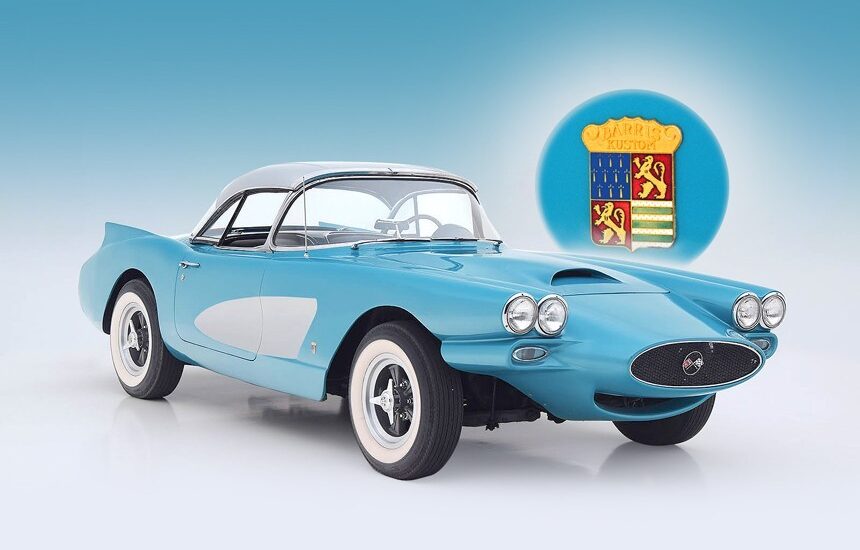At first glance, this vehicle might seem to be a lightly altered version of the experimental 1958 Corvette XP-700. However, the original prototype did not survive; it was transformed into the Corvette Mako Shark I. So, what exactly are we looking at? It’s neither a replica nor a straightforward repetition.

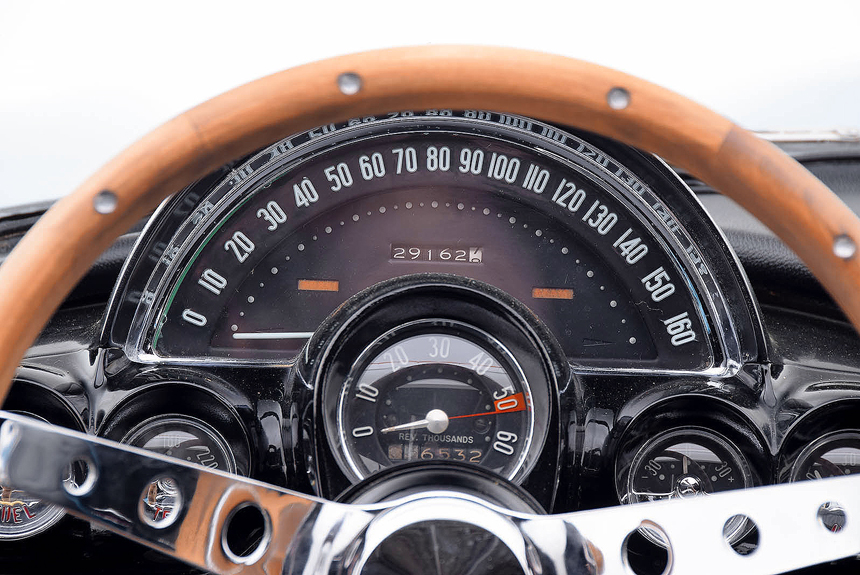
The instrument cluster is also, in general, standard – but the steering wheel with a wooden rim is most likely also an Accessories International product: the steering wheel on serial cars is not like this
The automobile featured here is firmly based on a 1958 Corvette, but its customization occurred much later, around the mid-1960s. The commission originated from Accessories International, a California-based company that specialized in the market of automotive accessories—mainly decorative elements like overlays, moldings, chromed engine valve covers, customized air filter housings, and other ornamental pieces. The firm acquired this second-hand vehicle and entrusted it to one of its major clients, Barris Kustom of Los Angeles.

The transmission lever proudly bears the word “HURST”: this company, founded in the same year 1958, supplied sports and racing equipment for cars of various brands

The handrail in front of the passenger seat is colloquially called a “sissy bar”, and the word “sissy” in this case does not mean “sister”, but “coward”, “girl”. Like, if you are so afraid of fast driving – grab, cling…
George Barris, the founder of Barris Kustom, is recognized as a pioneer of automotive customization—a movement that refines factory-standard vehicles with unique external and sometimes internal modifications, crafted through traditional handcrafting techniques. This movement often counters prevailing automotive trends, such as the excessive external decoration of serial cars from the 1950s.


The frontal treatment of the car quite accurately reproduces that of the XP-700 prototype, although not without deviations. Thus, the headlights should have had small visors on top, and the front sidelights in the openings of the additional air intakes of the cooling system also look slightly alien
Interestingly, the real identity behind the customization legend was not George Barris but Georgios Barkaris, an ethnic Greek and a first-generation immigrant. After his mother’s death, he and his older brother, Sam, were adopted by their uncle, taking on his surname, Barkaris. The brothers were inseparable, sharing interests in music and theater, and even jointly painting a vibrant, eye-catching color on their first car—a non-operational 1925 Buick.

The tail end was definitely done with some reference to another General Motors prototype, the Buick Wildcat II (1954)
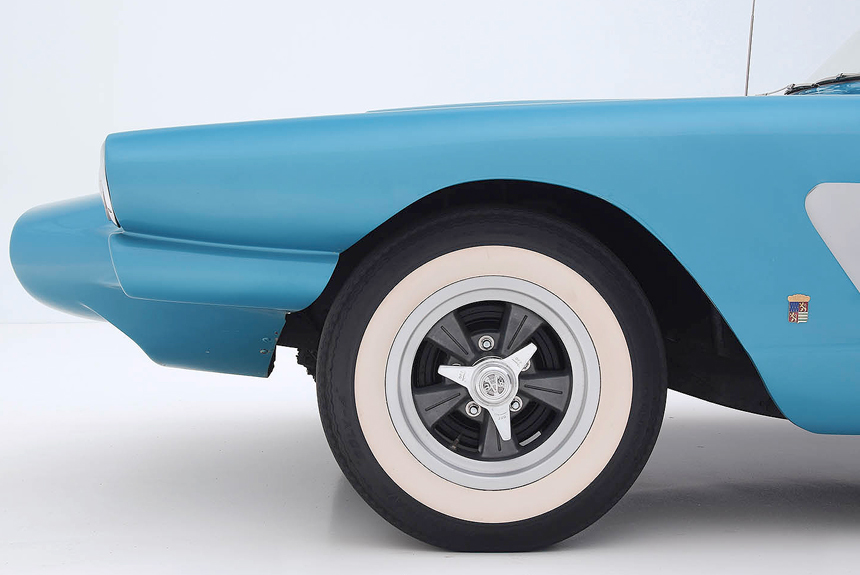
The wheels on the original XP-700 were spoked – and here, as we see, are products from Accessories International
During World War II, while Sam was drafted into the Navy, George moved to Los Angeles. His knack for vehicle modification didn’t go unnoticed; fellow servicemen impressed by his custom door locks—devoid of external handles—suggested he pursue a career in automotive bodywork. George eventually opened his own shop in a Los Angeles suburb, which flourished and relocated to the heart of the city, rebranded as Barris Kustom.


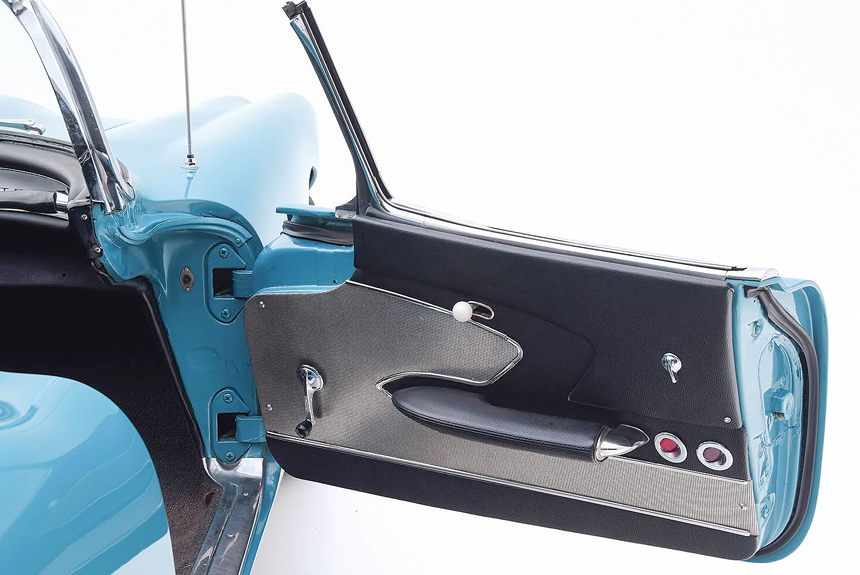
George Barris’s work caught the eye of Robert Petersen, founder of Hot Rod magazine, bringing Barris’s creations to a broader audience. Even the film industry sought out his unique designs, propelling Barris to the forefront of the customization scene. His projects were featured in movies and used by television studios, which needed creatively reimagined vehicles for their productions.


In addition to running his successful business, Barris was an active promoter of the custom car movement. He authored numerous articles offering advice and detailed accounts of his projects, further popularizing the craft.

The shining chrome in the engine compartment is the very same Accessories International products for which this car was created.
The blue Corvette shown here was crafted almost incidentally, as Barris was a frequent user of Accessories International products. He welcomed the opportunity to showcase their items in one of his projects. The front end of the car was inspired by the now-nonexistent XP-700 prototype, recreated from memory by Barris. He captured the distinctive oval radiator air intake and the overall front composition but left out non-functional but stylish elements like the side “gills.”
As for the rear of the car, while it echoed the design that would later be seen in the 1961/1962 production models of the Corvette, Barris added small “fins”—a feature never seen on Corvettes before. The project culminated in a display of various gleaming accessories from Accessories International, demonstrating the intricate blend of function and fashion.
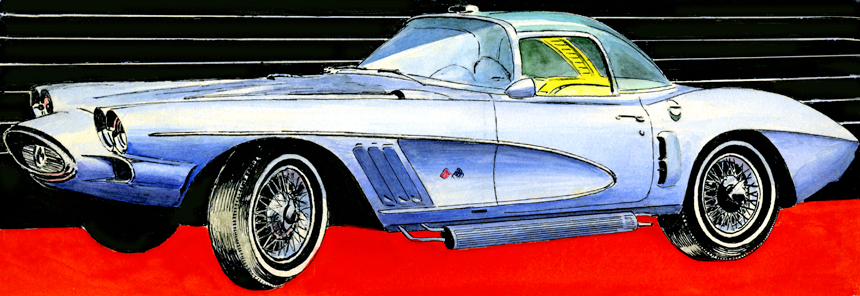
And this is what the real prototype of the XP-700 looked like. Feel the difference, as they say.
While Sam Barris eventually retired and passed away in 1967, George Barris continued to innovate and influence the automotive world until his death in 2015, just shy of his 90th birthday. His legacy as a style icon and pioneer in automotive customization endures, capturing the imagination of car enthusiasts and the spirit of innovation.
It’s a pity, indeed, that such talents fade, but their impact resonates through the decades.

The plastic of the sides is solved much more calmly than in the prototype XP-700: there are no “gills” behind the front wheel cutouts, no air intakes in front of the rear wheel cutouts, and the exhaust manifold running along the entire body is missing. The removable hard top is a standard serial one, it is only “decorated” with ventilation slots above the rear window.
This is a translation. You ca read the original article here: Рекламобиль: кастомизированный Chevrolet Corvette 1958 года в рассказе Андрея Хрисанфова

Published November 07, 2024 • 10m to read

